How To Fix High Temperature Shutdown
CPU computes several complex algorithms at the speed of billions of cycles per second. It is acceptable to generate some amount of heat while working at such keen speed.
A CPU temperature of 50-60 degrees Celsius at normal usage and 80-90 degrees during intensive work is quite common. Only if the processor exceeds this temperature, and then information technology is overheating. Unless your CPU is older or overclocked, overheating processor is usually the result of below-par heat dissipation.
Whatever the cause, we are going to prove how you tin intendance for your CPU and foreclose information technology from reaching higher temperatures.
Causes of an Overheating CPU
When a CPU overheats, it starts thermal throttling, and the performance decreases. But what actually rises the CPU temperature across its threshold? Allow'southward look at a few of the causes.
- Faulty CPU fan
- Accumulation of dust
- Inefficient air circulation
- Depleted thermal paste
- Low fan speed
- Overclocking the CPU
- Heavy programs running in the background
- Malware infection
Fixes for Solving CPU Overheating Issue
At first, yous need to be sure that your BIOS or the temperature monitoring awarding is showing the right reading. You tin use unlike software such as HWMonitor, Open up Hardware Monitor, etc., to detect the temperature. See if all of them denote your CPU to be overheated.
If so, let'southward movement on to the fixes right away.
Find Processor-Hogging Programs
The CPU is designed to handle high loads most of the time. Only some applications use a significantly high amount of processing power. When such programs run continuously in the background or foreground, information technology will cause the CPU to heat a lot.
Y'all can find such programs using Job manager and end them.
- Press Ctrl + Shift + Esc to open Task Director.
- Nether the Processes card, look for the programs and background processes with high CPU consumption.
- Select the plan and click Terminate job.

- Do this for all such applications and processes. Make certain you do non finish whatever system processes, though.
Sometimes, the programs run in the groundwork using the CPU silently. In such a example, you can disable background applications.
- Printing Windows + 'I' to open Settings.
- Find Apps and Apps & Features inside it.
- Click on the 3 dots at the right finish of an application and cull Advanced options. All applications may not have this characteristic.

- Discover the Groundwork apps permissions option.
- Set the Let this program run in groundwork characteristic to Never.

Restart your system and meet if information technology solved the effect. If the programs use loftier CPU again later on the restart, then we recommend you uninstall them. You tin also clean-boot your system to diagnose the exact process/application that's causing the loftier CPU usage.
Look for malware
Not all CPU-hogging programs are intentional. If your organization is infected with malware, they can utilise up the processor without whatsoever mercy. Equally a result, the CPU load increases, and it heats up more than its limit.
You should run a consummate virus scan on your arrangement using the Windows defender tool. You could utilize a third-party antivirus, merely it tin can consume boosted processing power. Let's run a virus scan using Defender.
- Press Windows + 'R' and enter
ms-settings:windowsdefenderto open Windows Security. - Click on Virus and Threat Protection and get to Browse options.

- Select Full scan and click Scan now.
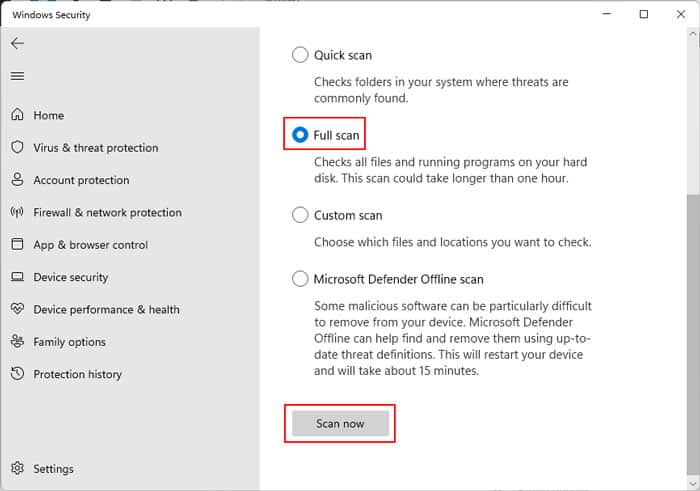
It can take a flake of time to consummate the scan and remove the malware. See if the CPU temperature reduces after the virus scan.
Utilise a Defended Graphics Unit of measurement
When you run a graphics-intensive program or merely a demanding application, it uses a lot of processing power. This can load the CPU even more than if you run those applications using integrated graphics. The integrated graphics unit uses the CPU'southward capacity to render the images.
So, if you continuously use heavy programs and play high-stop games, you lot should add a dedicated GPU to your arrangement. The defended GPU has its ain processor, memory, and cooling system.
Using a GPU reduces the pressure on the CPU fifty-fifty more if you enable the Hardware Acceleration feature. This characteristic removes some load from the processor and uses other organisation resources such equally GPU to run them.
Allow's see how you can enable Hardware acceleration on your system.
- Press Windows + 'I' to open Settings.
- Click on Brandish and coil to notice Graphics settings.
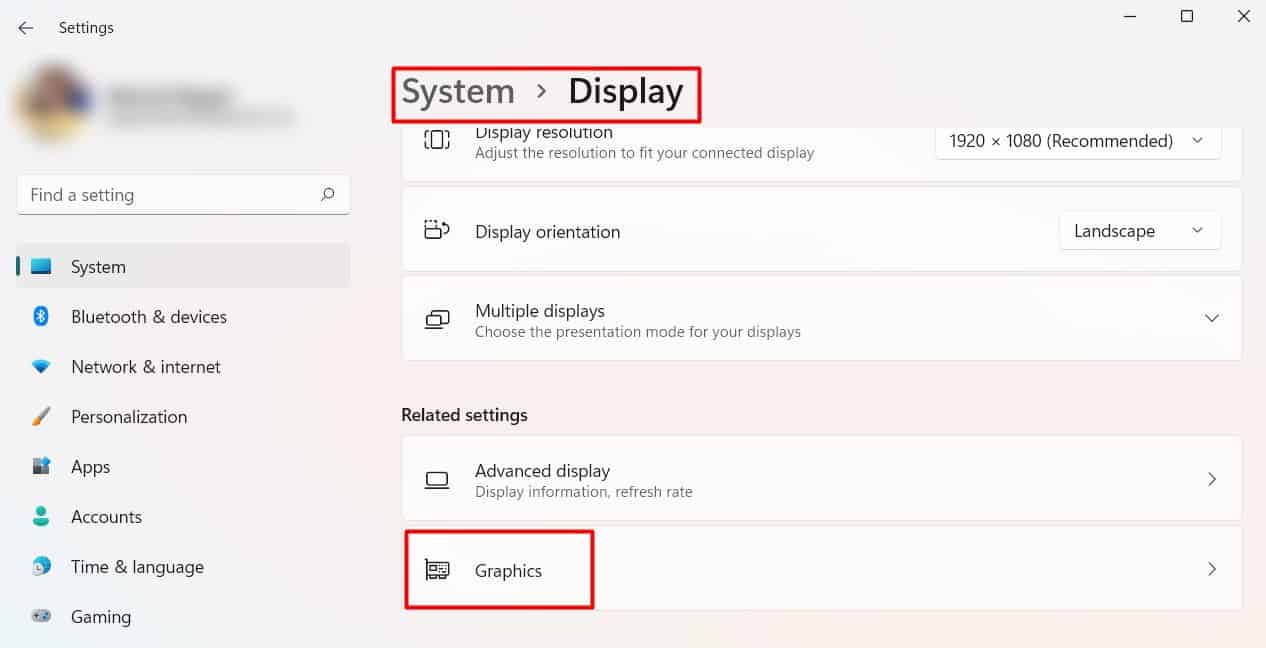
- Click on Default graphics settings at the top.
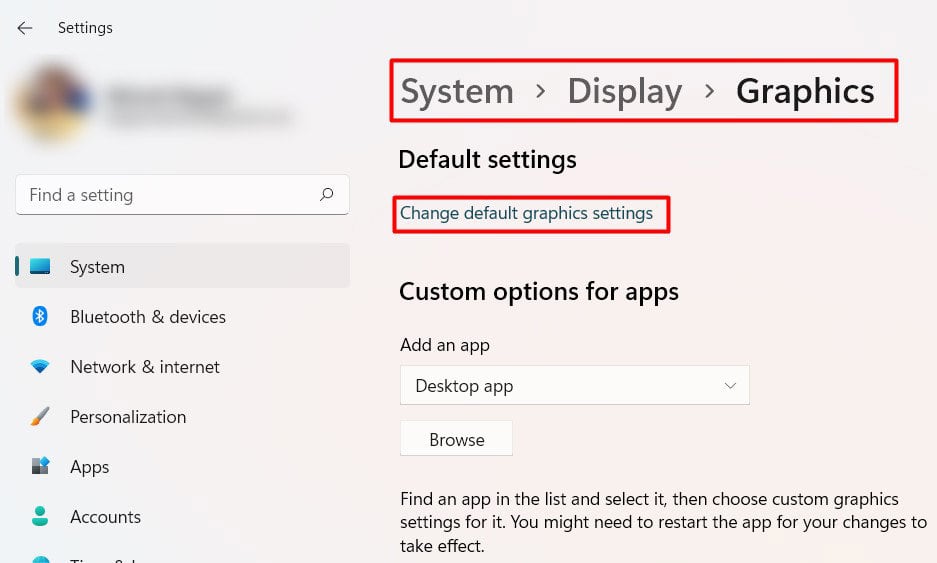
- Enable Hardware-accelerated GPU Scheduling by changing the toggle bar to On.

Y'all should discover your CPU temperature to decrease significantly.
Reduce Maximum Processor State
Windows provide an option to manage the ability plan and tweak the ability usage settings of your system. If you are facing the CPU overheating problem in a laptop, you lot tin can use a counterbalanced power plan or power-saving options. This provides a balanced operation and ability usage compared to the High-operation setting.
Similarly, you can likewise lower your Maximum processor country. If your processor is getting older and cannot handle higher loads, reducing the CPU usage percent can aid lower its temperature.
Permit's see how you lot can set these settings on your PC.
- Press Windows + 'R' and type
powercfg.cplto open up Power Options. - Ready the Balanced or Power saver plan.
- Click on change plan settings on the selected plan.
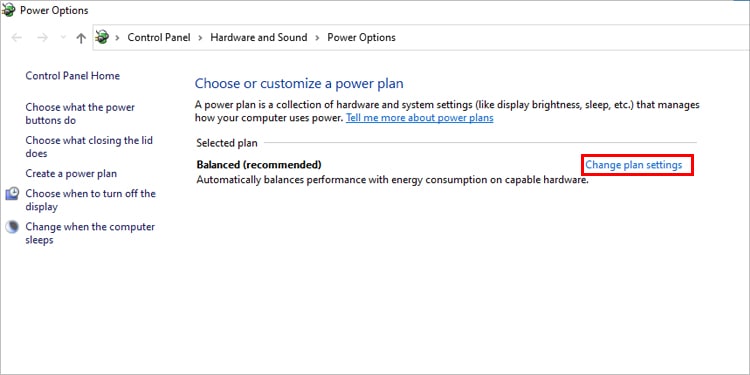
- Go to alter advanced ability settings.
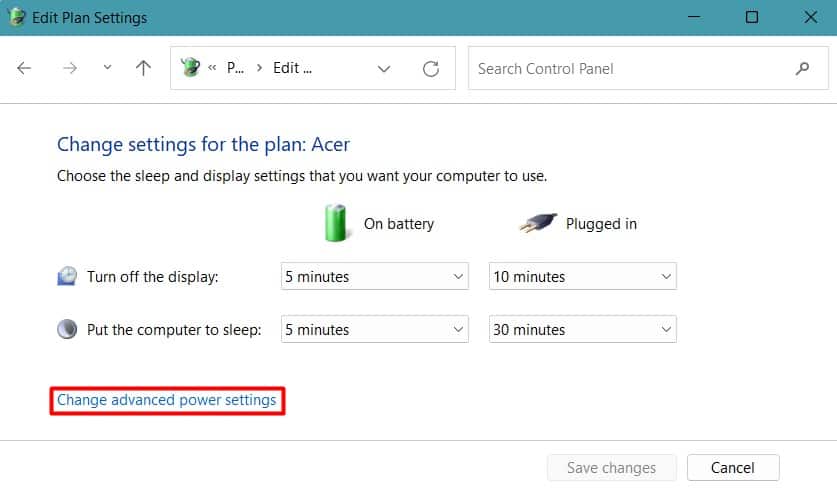
- Find Processor ability management.
- Set the Maximum processor land to threescore-seventy %. It depends on how much performance reduction you want to trade for lower CPU temperature.

See if the CPU's temperature comes to the normal range.
Cease overclocking
Most of us overclock our CPU to get the best functioning out of it. It does the task excellently too. But overclocking can increase the CPU temperature and then much that it throttles to preserve its integrity.
If y'all have overclocked your CPU, it may be a major reason for its high temperature. So, you should revert the overclocked settings to normal performance. Permit's see how you tin practice it.
- Boot your system into the BIOS page by pressing the respective fundamental repeatedly later the system starts.
- Load the default settings by pressing F9 or the associated push button.
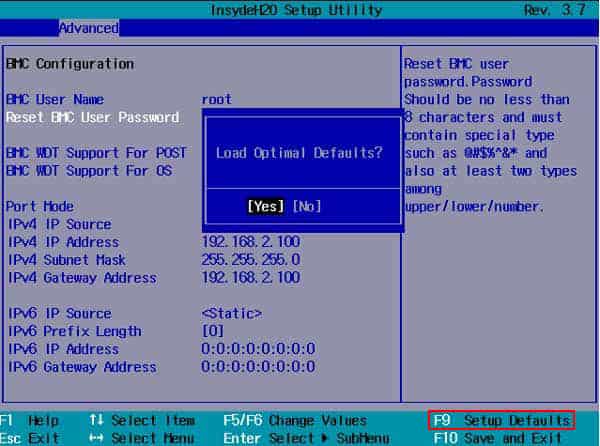
- Save the settings and restart your PC.
Yous can simply uninstall the program if yous have used software to overclock your CPU.
- Press Windows + 'R' and blazon
appwiz.cplto open Add or Remove Programs.

- Select the programme and click Uninstall.
You should observe your CPU running at normal clock speed and its temperature back to normal. In addition to overclocking, if you are agile in cryptocurrency mining and use other heavy programs, they consume a lot of processing power. Then, yous can uninstall those programs to come across whatever changes in the CPU temperature.
Check CPU Fan or AIO Pump
CPU fan is the major component responsible for maintaining the CPU temperature. If the fan is non working properly or is damaged, the CPU won't get adequate cooling.
So, you need to verify that the fan'southward cablevision is not damaged or unplugged and its speed is sufficient for your system. Let'due south detach your system to do information technology.
- Power your system off and remove all the ability cables.
- Remove the side panel by unscrewing the nuts.
- Find the CPU fan and its header on the motherboard.
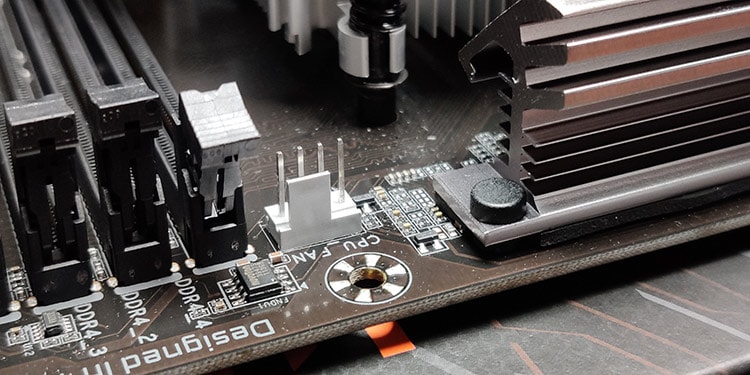
- Connect the ability cables and run the arrangement to run into if the fan is spinning properly.
- Open up some intensive programs and look whether the fan speed increases appropriately.
- If information technology does non work properly, remove the power cables again and disconnect the fan connector.
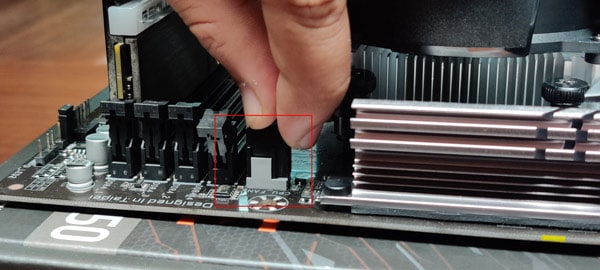
- Check the fan cablevision for any impairment and insert it back properly. The correct CPU fan header is named CPU_FAN. CHA_FAN or SYS_FAN named header are for casing fans.
- If you have an AIO Pump, look if the radiator fan is fully functional.
Before re-assembling the system, allow'south clean information technology showtime.
Clean the PC
Grit is the enemy which nosotros can't really avoid. Our system suffers from overheating issues when also much dust accumulates. It clogs the vents, slows down the fan, and insulates the heat sinks preventing them from dissipating estrus.
So, if you have non cleaned your PC in a while, the clay collected on the CPU fan may have resulted in overheating of the CPU. While y'all are checking the fan, you demand to clean your heatsink and the PC and gratis it from any dust.
- Disconnect all the connectors and hardware from the motherboard.
- Remove the motherboard screws and take information technology out of the casing.
- Employ a blower to provide compressed air through the motherboard. Exercise non leave whatsoever nooks and corners.
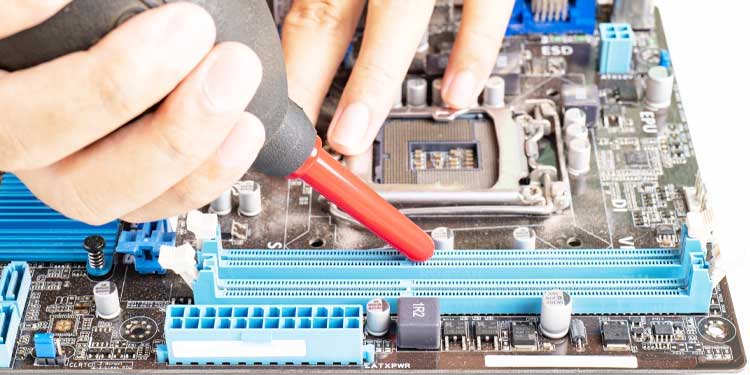
- Wipe the grit on the CPU fan, and other heat sinks with a clean microfiber cloth.

- Reconnect the motherboard and the connectors on information technology.
Operate your organization and discover if the CPU temperature rises again.
Maintain Proper Airflow
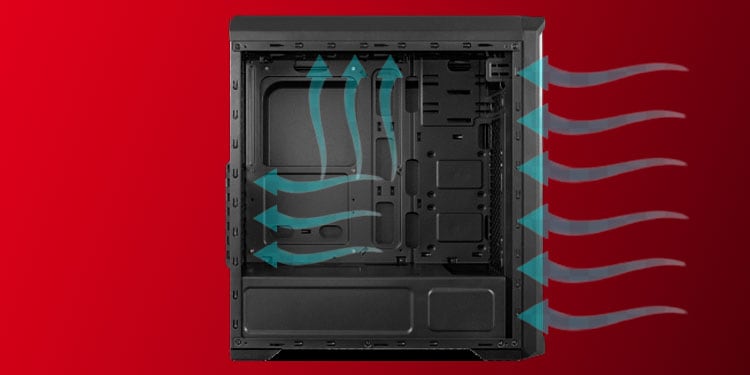
The CPU fan draws the cold air inside and then pushes abroad the hot air to dissipate the heat generated in the CPU. Only if the area is so congested that the fan cannot remove the air exterior, the oestrus won't get prodigal. As a issue, the CPU overheats.
This effect is more pronounced in laptops when you use them over a soft surface. The soft surfaces such as the mattress, shrink and block the vents.
Similarly, if the room air itself is hot or there is excessive sunlight falling on the system, so it volition automatically oestrus up.
Then, yous should apply your system in a room or identify with plenty space for air circulation. Even ameliorate if the room has cooler airflow. Use the laptop on hard surfaces such as books or tables. It is more benign to get a laptop cooling pad.
Re-apply Thermal Paste
Thermal paste removes air bubbling between the CPU fan's bottom and the processor to reduce insulation at the microscopic level. Thus, the heat gets transferred from the CPU to the heat sink much more than effectively.
But, over time, the thermal paste degrades, and the heat dissipation process may exist ineffective, causing the CPU to overheat. Thus, yous should remove the old thermal paste and re-apply the new one to the processor.
- Remove the ability from the system and detach the casing to go to the CPU.
- Unscrew the CPU fan and remove the lock.
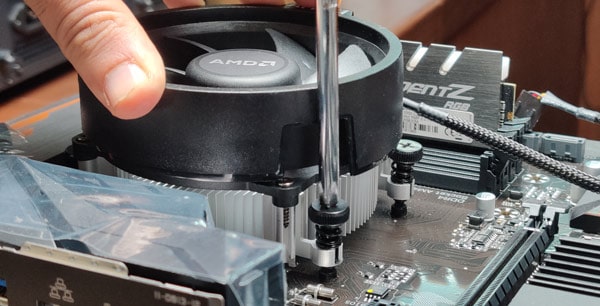
- Disconnect the fan header and take the fan out.
- Rub the residual of the thermal paste using cotton wool or soft cloth and a little Isopropyl booze.

- Let the processor's top dry out for a while.
- Put an appropriate amount of thermal paste on the processor or the fan's lesser.
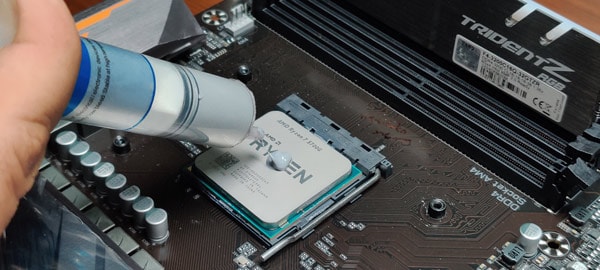
- Place the fan on the acme appropriately.
- Lock the fan mounts diagonally to maintain stability.
- Connect the fan header and get together the system.
Run the computer to come across any changes in the CPU temperature.
Undervolt your CPU

When the processor's load increases, it draws more than power from the power supply unit. The high ability draw increases the temperature in return. Undervolting a CPU means reducing its maximum working voltage by keeping its operating speed constant. So, when the voltage decreases, the temperature also reduces accordingly.
Undervolting is one of the most used techniques to lower the CPU temperature. It is totally safe and, if done at an advisable level, increases the performance even more. Only there are several steps to follow while doing information technology. So, we have prepared a detailed guide on how to undervolt your CPU safely.
Increase CPU Fan speed
Sometimes the fan speed may not be sufficient to suffice the workload of the processor. This can result in inefficient cooling and eventually overheating of the CPU.
However, you lot can alter your CPU fan's speed if your manufacturer has it unlocked and works in PWM mode. The speed of a DC fan cannot exist varied. Let'southward see the way to increase fan speed using BIOS.
- Restart your organization and kick into the BIOS folio by pressing the corresponding push for your organization. By and large the key is F2, F12, or Delete, depending on the organization.
- Notice Q-Fan, Fan info, or Smart Fan choice in BIOS. The name varies as per manufacturers.
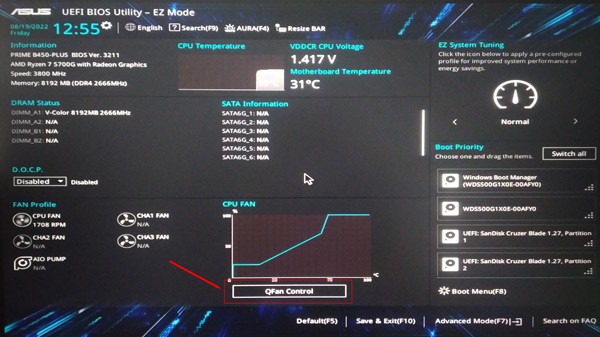
- Raise the fan speed by tweaking the fan curve. You tin too use the automated way such equally Turbo, which increases its speed.
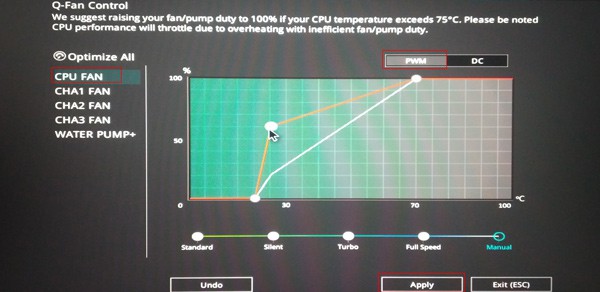
- Save the settings and boot into normal mode.
Run your system for a while and see if the CPU crosses its threshold temperature again. If your BIOS does not have the advanced pick to modify fan speed, you can utilise reliable tertiary-party applications such as MSI-Afterburner, SpeedFan, etc.
Delid Your CPU (Only for Professional Users)
If you lot want to keep your CPU temperature reduced farther, so you can perform its delidding. It is the process of removing the top metal portion (lid) of the CPU.
The metallic portion and the bodily circuit consist of minute air pockets that heighten the temperature. The metallic lid is kept in that location just for protection. Removing information technology will bring the CPU in straight contact with the heat sink, improving the cooling efficiency much more than. Information technology can even reduce the temperature while keeping the CPU overclocked.
The basic process is that you demand to remove the chapeau, scrub the Integrated Oestrus Spreader (IHS) and apply the new one. But the process is risky and requires a lot of steps. Nosotros have provided a detailed guide demonstrating the safe process of delidding the CPU.
Source: https://www.technewstoday.com/cpu-overheating/

0 Response to "How To Fix High Temperature Shutdown"
Post a Comment